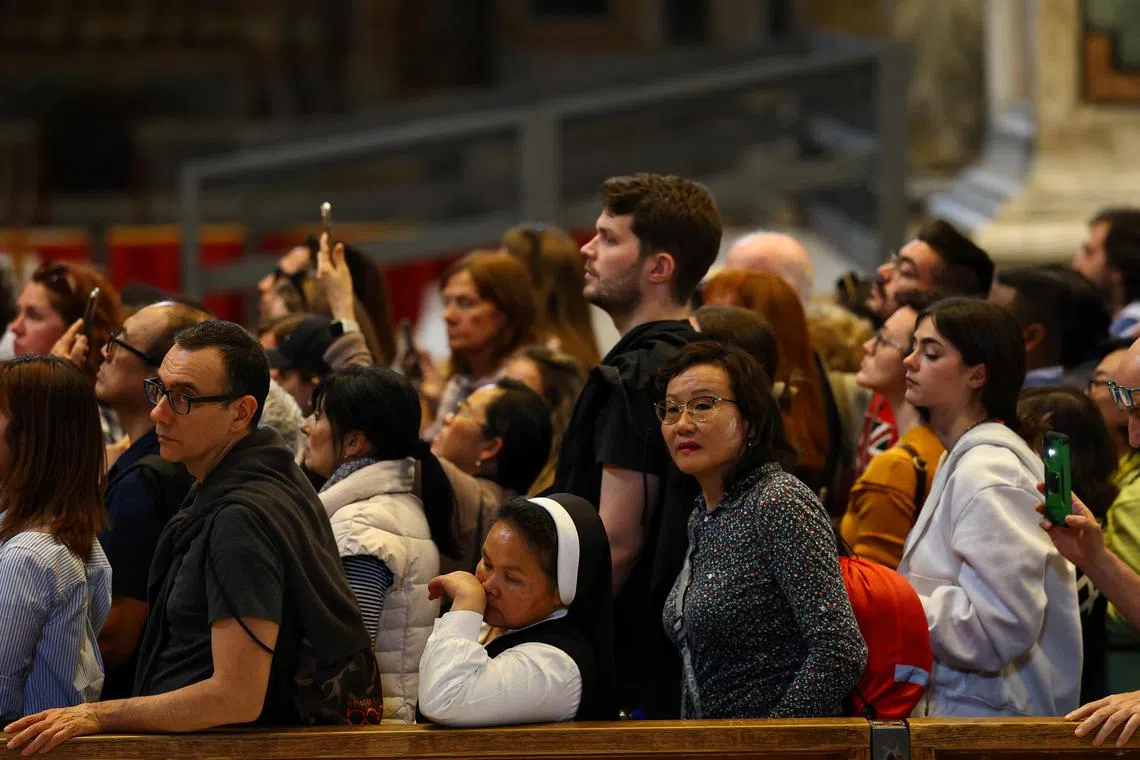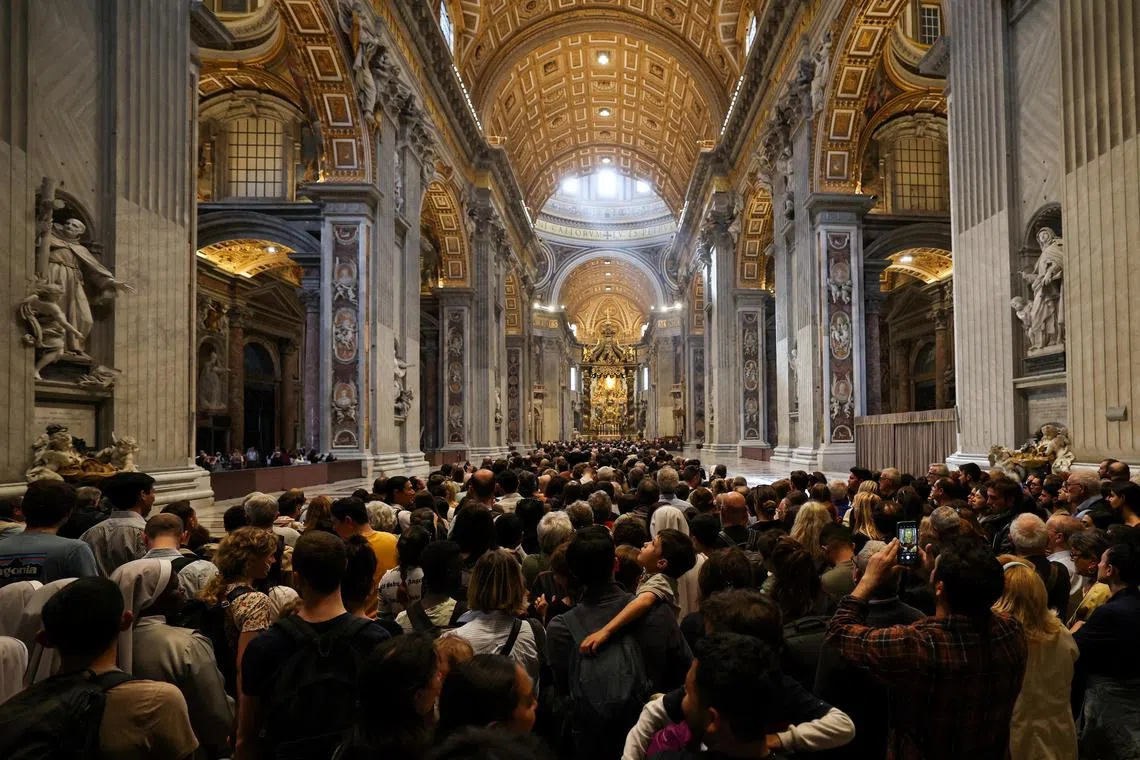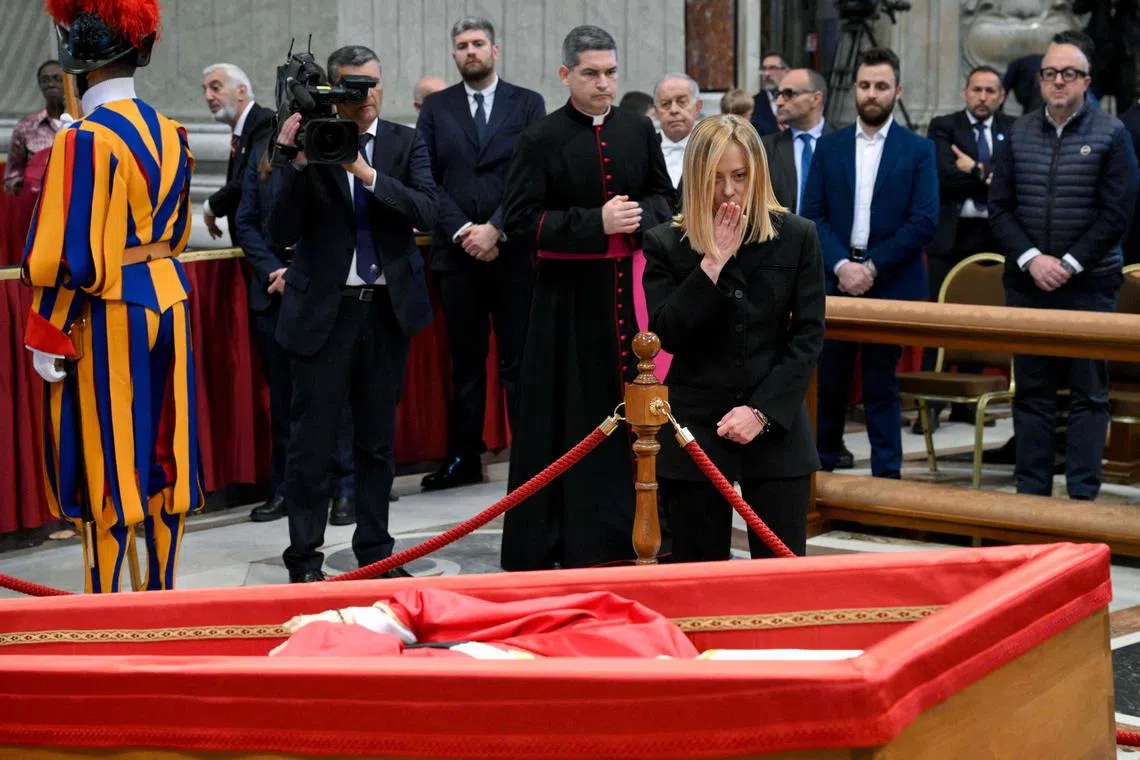Tens of thousands bid farewell to Pope Francis as he lies in state
Sign up now: Get ST's newsletters delivered to your inbox

People queueing to pay their respects as Pope Francis lies in state in St Peter's Basilica at the Vatican, on April 23.
PHOTO: REUTERS
Follow topic:
VATICAN CITY – Tens of thousands of mourners queued to say their last goodbyes to Pope Francis at St Peter’s Basilica on April 23, as the body of the late Argentine pontiff began three days of lying in state.
By the afternoon, the wait to enter the church was more than four hours, as the long line of pilgrims and tourists wishing to pass by the pontiff’s open coffin circled the vast St Peter’s Square.
“We wanted to say thank you to one of the most humble popes,” said Portuguese medical student Francisca Antunes, 21, after leaving the basilica with a friend.
“It felt really good to be in there,” she told AFP.
Roman pensioner Simonetta Marini, 67, said the crowds attested to widespread admiration for Pope Francis, whose human touch and defence of the world’s underdogs helped steer the Roman Catholic Church towards a more inclusive, compassionate path.
“I came to say a last goodbye to a great man. He stood for the people,” Ms Marini said.
Pope Francis, an energetic reformer who took over as leader of the world’s 1.4 billion Catholics in 2013, died on April 21, aged 88.
His death, after a stroke,
Dressed in his papal vestments – a red chasuble, white mitre and black shoes – and with a rosary laced between his fingers, the Pope’s body has been laid out in a red-lined wooden coffin.
For three days, it will rest on a low bier before the Altar of the Confession underneath the soaring dome painted by Michelangelo, before being closed at 8pm on the evening of April 25 ahead of the April 26 funeral.
Procession of cardinals
Ms Vincenza Nocilla, a 67-year-old retired nurse, left her home in Formia, south of Rome, at 4am to be among the first to see the pontiff.
She said it was “really moving” but noted, however, that “they don’t let you stay long, you walk by, say a quick goodbye and go”.
A retired Irish couple said it was a “priority” to come and see Pope Francis while on holiday in Rome, and hailed his efforts to tackle clerical sexual abuse.
“He was a great man, a great advocate for the poor, the underprivileged and those who suffered at the hands of his flock,” said Ms Cliodhna Devlin.

People queueing to pay their respects as Pope Francis lies in state in St Peter’s Basilica at the Vatican, on April 23.
PHOTO: REUTERS
The Vatican said that because of the large turnout it was considering keeping the basilica open past its scheduled closing time at midnight.
Hours before, a colourful procession of cardinals, clergy and Swiss Guards escorted the Pope’s coffin from the chapel of the Casa Santa Marta, where he lived during his 12-year papacy, to St Peter’s, as the basilica’s bells tolled.

Pall-bearers, next to Swiss Guards, carrying Pope Francis’ coffin from the chapel of Casa Santa Marta to St Peter’s Basilica, on April 23.
PHOTO: AFP
Scores of world leaders and dignitaries plan to attend the April 26 funeral, including US President Donald Trump, Ukraine’s Volodymyr Zelensky, Argentine President Javier Milei and Spain’s royal couple.
Up to 170 foreign delegations are expected, the Interior Ministry said.
‘Sorely missed’
Italian Prime Minister Giorgia Meloni on April 23 led the tributes during a special joint session of Parliament in Rome, before going herself to see the Pope lying in state.
In Parliament, she described Pope Francis as a “determined” man who nevertheless made others feel at ease.
“With him you could talk about everything. You could open up, and tell your story without filters or fear of being judged,” Ms Meloni said, adding that the last thing he told her was never to lose her sense of humour.

Italy’s Prime Minister Giorgia Meloni paying her respects to Pope Francis at St Peter’s Basilica on April 23.
PHOTO: AFP
After the funeral, the Pope’s coffin will be taken to his favourite church, Rome’s papal basilica of Santa Maria Maggiore, where it will be interred in the ground and marked by a simple inscription: Franciscus.
The authorities have ramped up security for the funeral, with the weekend already due to be busy because of a public holiday on April 25.
A spokesman for Italy’s civil protection unit, Mr Pierfrancesco Demilito, told AFP it was impossible to predict the expected crowds, but estimated “several hundred thousand at least”.
Italy has declared five days of national mourning – longer than the three days observed for Polish Pope John Paul II in 2005, but less than the week declared for Pope Francis by his native Argentina.
The Philippines – one of the world’s most populous Catholic-majority countries – also declared four days of national mourning.
Thoughts for the late Pope came from as far afield as East Timor, which he visited in 2024, with rector Miguel Arcanjo da Costa of Dili’s largest Catholic seminary calling him “a diamond for us”.
“We hope that the next pope is like him,” the rector added.
Cardinals to meet
After the funeral, all eyes will turn to the process to choose Pope Francis’ successor.
Cardinals around the world are returning to Rome for the conclave, which should begin no fewer than 15 days and no more than 20 after a pope’s death.
Only those under the age of 80 are eligible to vote.
Cardinals have already met twice, in so-called general congregations – the first time on the morning of April 22, where they set the funeral date, and again on the afternoon of April 23.
At the time of his death, Pope Francis was under doctors’ orders to rest for two months. But the headstrong pontiff continued to make public appearances despite appearing tired and short of breath.
On Easter Sunday, he circled St Peter’s Square in his Popemobile to greet the crowds, stopping to kiss babies along the way.
He died the next morning after a stroke, a coma and heart failure, according to his death certificate. AFP

